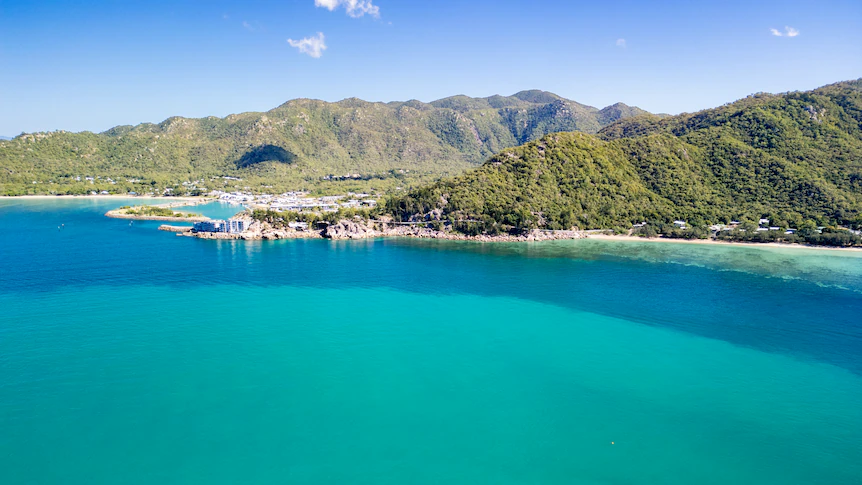By Baz Ruddick,Meghan Dansie
Copyright abc

Just a 15-minute ferry ride from the growing northern industrial hub of Townsville in North Queensland lies a tropical island paradise on the Great Barrier Reef’s doorstep.
Tourists flock to Magnetic Island to see green sea turtles and unique underwater coral reefs, but when the winds change, so do the conditions underwater — visibility is reduced to almost nothing.
Gethin Morgan from Magnetic Island Nature Care believes in his 30 years on the island, the underwater environment has degraded.
“When the wind blows and you’ve got a few days of strong wind the whole bay just gets muddy right into these little bays,” he said.
He blames the Port of Townsville and its maintenance dredging program, which allows silt and mud to be dumped in the bay.
“We’re pushing for it to be dumped in deeper water but before that could happen there needs to be proper modelling done now,” he said.
Mr Morgan believes the fine silt, dredged from the shipping channel, is being washed onto the island’s inshore reefs.
“It’s a tremendous refuge, it’s a biodiversity hotspot. Cleveland Bay is really important,” he said.
The port will next year begin planning for how to deal with the dredged material over the next decade.
Dredging maintains port operations
Dredging is required to keep shipping channels clear up and down the coastline, with one hopper dredge, owned by the Port of Brisbane, servicing nine Queensland ports year-round.
That includes the Port of Townsville, where the channel was recently widened as part of a $251 million expansion completed in late 2024, allowing vessels of up to 300 metres to berth.
For a month each year, the Port of Townsville dredges 400,000 to 450,000 metres cubed of sediment from the city’s shipping passage.
It is permitted to dispose the mud at an underwater depth of 10 to 16 metres, in an area that was excised from the Great Barrier Reef Marine Park as a Dredge Material Placement Area.
Reef always in cycle of stress and recovery
Silt can cause damage to coral by blocking light, which inhibits the ability of the algae living in the coral to photosynthesise and feed the coral.
But Andy Lewis, a marine biologist and the executive director of not-for-profit the Coral Sea Foundation, said the reefs around the island were in good condition.
“There is no doubt that the dredging is increasing sediment load in the water, but the reefs around here are adapted to living in a high sediment environment,” he said.
Dr Lewis, who has dived Magnetic Island’s reefs for more than 25 years and kept records of recovery, did not believe there was evidence of long-term decline in coral cover as a result of dredge activity.
“Some of the highest coral cover reefs we have around the island are in areas of exceptionally high sediment flow,” he said.
He said the shallow average depth of water and sediment run-off from the mainland nearby made the environment naturally turbid, and that cyclones had also taken a toll.
“[Cyclone Tessi]took out a lot of those corals in the intertidal [zone]but the subtidal corals below the high tide mark are still in really good condition,” he said.
However, he still believed the best-case scenario for the environment would be putting all dredge spoil on land, particularly in the face of increasing stress on the reef.
“I think everything that we can do now to limit the amount of pressure on our reef system is valuable,” he said.
Oceanographer Eric Wolanski recently published a paper on the health of the Cleveland Bay ecosystem, suggesting dredging had exacerbated the bay’s natural murkiness by adding more sediment.
“The water has become very turbid and it has decreased from 8m visibility in the 1960s to 1m nowadays,” Dr Wolanski said.
The Port of Townsville has monitoring buoys in place around the bay that monitor water quality.
It is one of several in Queensland, like Gladstone and Cairns, permitted to dump maintenance dredge spoil in designated marine areas.
Dr Wolanski is critical of the monitoring.
He believes silt was affecting reefs on the western side of the island where there are no permanent water monitoring buoys in place.
“It’s completely unsustainable. It’s not an example we should use to plan for the future,” he said.
Placement site to be reviewed from next year
In a statement, a Port of Townsville spokesperson said it would consider “community feedback” on where to put the dredge spoil as part of its next management plan.
“We are currently preparing for our next 10-year sea placement application,” they said.
“As part of our commitment to best practice, we will review all available science, community feedback and regulatory guidance as part of the application process.”



